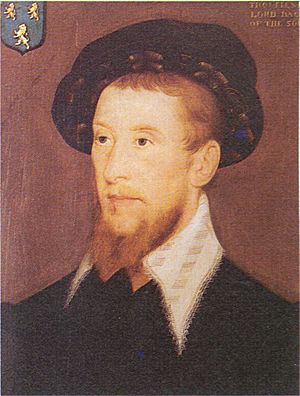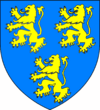Thomas Fiennes, 9th Baron Dacre facts for kids
Quick facts for kids
The Lord Dacre
|
|
|---|---|
| Baron Dacre | |

Thomas Fiennes, Baron Dacre
|
|
| Coat of arms |  |
| Reign | Henry VIII |
| Predecessor | Thomas Fiennes, 8th Baron Dacre (grandfather) |
| Successor | Gregory Fiennes, 10th Baron Dacre |
| Born | Thomas Fiennes c. 1516 |
| Died | 29 June 1541 (aged 24–25) Tyburn |
| Buried | St Sepulchre-without-Newgate |
| Noble family | Fiennes |
| Spouse(s) | Mary Fiennes |
| Issue | |
| Father | Sir Thomas Fiennes |
| Mother | Jane Sutton |
Thomas Fiennes, 9th Baron Dacre (around 1516 – 1541) was an important English nobleman. He lived during the time of Henry VIII, a famous king. Thomas Fiennes was the son of Sir Thomas Fiennes and Jane Sutton. He is remembered for an unfortunate event that led to his early death.
Contents
Early Life of Thomas Fiennes
Thomas Fiennes was born around 1516. His father, Sir Thomas Fiennes, passed away in 1528. This meant young Thomas became the next in line for his grandfather's noble title. He also became the future owner of the family home, Herstmonceux Castle in Sussex. Thomas became the 9th Baron Dacre in 1533, when he was about 19 years old.
Family and Marriage
In 1536, Thomas Fiennes married Mary Nevill. Mary was the daughter of George Neville, 5th Baron Bergavenny. Together, Thomas and Mary had three children:
- Thomas Fiennes, who sadly died at age fifteen in 1553.
- Gregory Fiennes, 10th Baron Dacre, who later inherited the title.
- Margaret Fiennes, 11th Baroness Dacre, who also became a Baroness.
Public Service and Royal Events
Lord Dacre had several important roles in his career. In 1536, he was part of the jury for the trial of Anne Boleyn, King Henry VIII's second wife. He also served on juries for other important figures. These included Lord Darcy and Lord Hussey in 1537. They were involved in a protest called the Pilgrimage of Grace. In 1538, he was on the jury for Baron Montagu.
Thomas Fiennes also attended royal events. In October 1537, he was at the baptism of Prince Edward, the king's son. The next month, he helped carry the canopy at Queen Jane's funeral. In 1539, he was among the lords who welcomed Anne of Cleves when she arrived in England.
A Tragic Event
In April 1541, Lord Dacre and some friends went hunting. They were on land belonging to Sir Nicholas Pelham without permission. During this outing, they met some of Pelham's servants. A fight broke out between the two groups. Sadly, one of Pelham's servants, John Busbrig, was badly hurt and later died.
Because of this event, Lord Dacre and others faced serious consequences. He admitted what had happened, hoping the King would be merciful. However, King Henry VIII decided that Lord Dacre should be punished. On June 29, 1541, Thomas Fiennes was put to death in London. His body was later buried at St. Sepulchre's Church.
After this tragic event, Lord Dacre's family lost their lands and noble title. However, the title was later given back to his second son, Gregory, in 1558. His older son, Thomas, had passed away before this happened.
Images for kids
-
Hans Eworth's portrait of Mary Neville, with a posthumous image of her husband in the background



